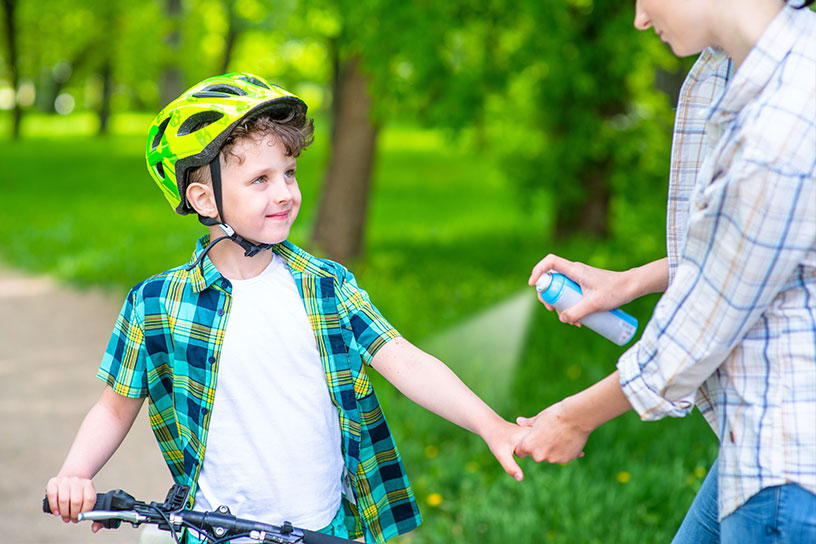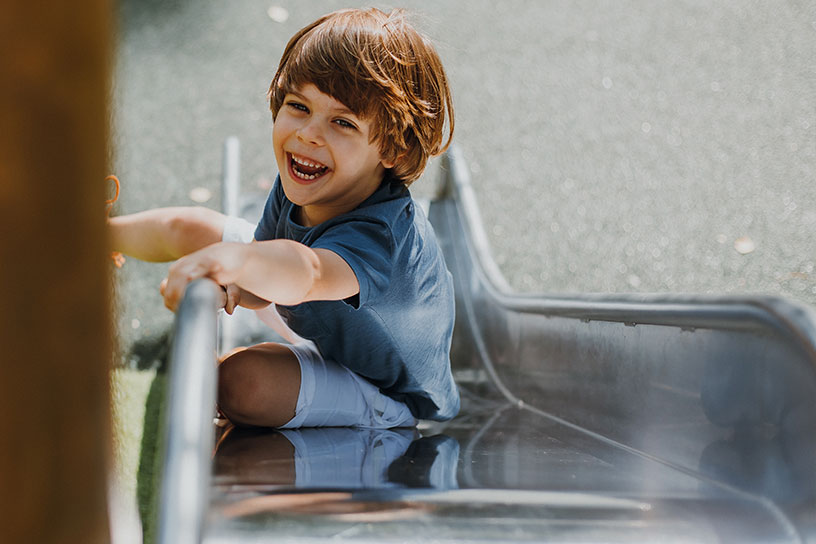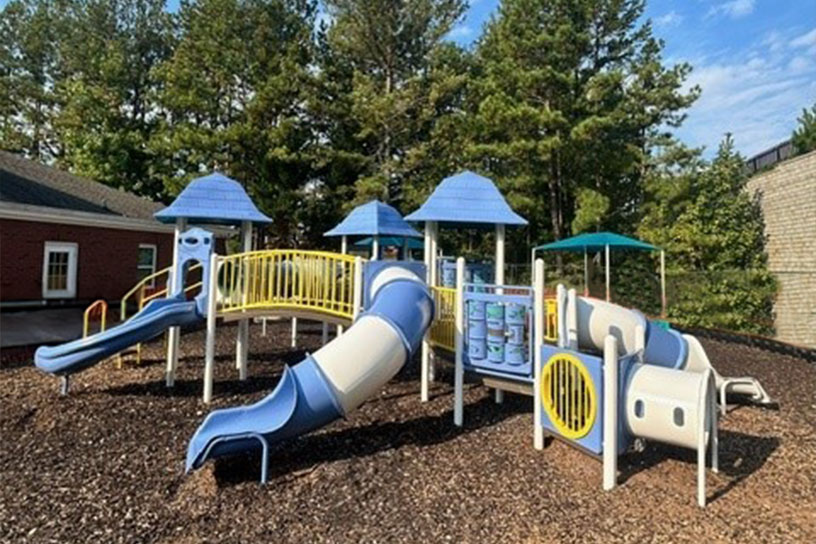Playground slides offer children endless fun and excitement, but it's crucial to prioritize their safety. Regular inspections, proper maintenance, and adherence to safety guidelines are essential for preventing accidents. This is an in-depth guide on inspecting and testing playground slides. We'll also explore different types of slides, including roller slides, spiral slides, straight slides, embankment slides, and tube slides, while highlighting important considerations for each type.
Slide Platform Safety
Slide platforms play a vital role in ensuring a safe transition from standing to sitting at the top of the slide. Here are key platform requirements:
- Toddlers: The platform should be at least 19 inches deep.
- Preschool-age and School-age children: The platform should be at least 14 inches deep.
Slide platforms should be horizontal and as wide as the slide chute and it should be surrounded by guardrails or barriers. The platform should not have any spaces or gaps that can trap clothing, strings, or body parts. Handholds should be provided to facilitate a safe transition from standing to sitting, and they should be positioned at an appropriate height. A device such as a guardrail, hood, or other means should discourage climbing at the entrance to the chute.
Slide Chute Safety Recommendations and Requirements:
- Embankment Slides
The slide chute of an embankment slide should have a maximum height of 12 inches above the ground surface. They should follow recommendations for straight slides, such as side height, slope, and use zone at the exit. Measures should be in place to discourage the use of embankment slides by children on skates, skateboards, or bicycles. - Roller Slides
Roller slides should meet general recommendations, including side height, slope, and use zone at the exit. The space between adjacent rollers and between the rollers and the stationary structure should be less than 3/16 inch. Frequent inspections are recommended to ensure the absence of missing rollers or broken bearings. - Spiral Slides
Spiral slides should follow recommendations for straight slides. Special attention should be given to design features that may present unique challenges, such as lateral discharge of users. For toddlers and preschool-age children, shorter spiral slides (one 360° turn or less) are recommended due to their limited balance and postural control. - Straight Slides
Flat open chutes should have sides at least 4 inches high for the entire length of the inclined sliding surface. The sides should be integral to the chute without any gaps. These requirements apply to both flat open chutes and tube slides.
Slide Use Zone Safety
The use zone around a slide ensures a safe play environment, consider the following recommendations:
- Toddlers in a Limited Access Environment
The use zone should be at least 3 feet around the slide's perimeter. The area at the end of the slide should not overlap with the use zone of other equipment. - Toddlers in Public Areas with Unlimited Access
For standalone slides, the use zone should be at least 6 feet around the perimeter. For slides integrated into a composite structure, a minimum of 3 feet is required between the access components and the slide chute. The use zone at the slide's end should be at least 6 feet and should not overlap with other equipment's use zone. - Preschool and School-age Children
The use zone in front of the slide's access and sides should extend at least 6 feet from the equipment's perimeter. The use zone in front of the slide's exit should not overlap with any other equipment. The length of the use zone in front of the exit should be at least 6 feet for slides up to 6 feet high and correspondingly longer for taller slides, up to a maximum of 8 feet.
Playground Slide Fall Height
The fall height of a slide refers to the distance between the transition platform and the protective surfacing below. It is important to ensure that the protective surfacing meets safety requirements to minimize the risk of injuries.
Recommended types of surfacing for around slides:
- Engineered Wood Fiber (EWF)
Engineered wood fiber, also known as wood mulch, is a popular choice for playground surfacing. It is made from shredded wood fibers and provides excellent impact attenuation. EWF is a cost-effective option that meets safety standards when properly installed and maintained. It is important to maintain an adequate depth of EWF to ensure optimal safety performance. - Rubber Mulch
Rubber mulch is made from recycled rubber, typically from tires, and offers a cushioned surface for falls. It provides good impact absorption and durability. Rubber mulch is available in various colors and can enhance the visual appeal of the playground. It requires less maintenance compared to EWF but can be more expensive. - Poured-in-Place (PIP) Rubber
PIP rubber surfacing consists of a two-layer system: a base layer made of recycled rubber granules and a top layer of colored EPDM rubber. This type of surfacing offers excellent impact attenuation, slip resistance, and accessibility for individuals with disabilities. PIP rubber is highly durable and requires minimal maintenance. It is a premium option that provides a seamless and attractive surface. - Synthetic Turf
Synthetic turf is a synthetic grass-like surface that provides a natural appearance while offering safety benefits. It offers good impact attenuation, especially when combined with an appropriate shock-absorbing pad beneath the turf. Synthetic turf requires regular maintenance, such as brushing and occasional disinfection, to keep it clean and safe. - Rubber Tiles
Rubber tiles are interlocking or glue-down rubber panels that create a resilient and slip-resistant surface. They are available in various thicknesses and offer good impact absorption. Rubber tiles are durable and require minimal maintenance. They can be an excellent choice for small play areas or areas with specific design requirements.
Regardless of the surfacing material chosen, it is essential to ensure that the depth or thickness of the surfacing complies with safety standards and manufacturer recommendations. Regular maintenance, including raking, replenishing, and addressing any damaged areas, is crucial to maintaining the effectiveness of the surfacing.
Addressing Playground Entanglement Hazards
Clothing entanglement on playground slides can lead to serious injuries, making it crucial to take preventive measures. Here are some additional steps to reduce the risk of clothing entanglement:
- Eliminate Protrusions and Gaps
Regularly inspect the slide to identify any protrusions, sharp edges, or gaps that could catch clothing. Pay close attention to areas where the slide components connect or where different materials meet. Make sure all connections and joints are smooth and securely fastened. - Conduct Routine Playground Inspections
Implement a regular inspection schedule to proactively identify any potential entanglement hazards. Inspections should be carried out by trained personnel who can thoroughly assess the slide's condition and identify any issues that may pose a risk. Consider conducting inspections at least once a month or more frequently for heavily used playgrounds. - Promptly Repair or Address Hazards
If any gaps, protrusions, or other entanglement hazards are identified during inspections, take immediate action to rectify them. Depending on the severity of the issue, this may involve repairing or replacing parts of the slide, filling gaps, or smoothing out rough edges. Promptly addressing hazards ensures that the slide remains safe for children to use. - Follow Manufacturer Guidelines
Always follow the manufacturer's guidelines and recommendations for maintenance and repairs. Manufacturers often provide specific instructions on how to address entanglement hazards for their particular slide models. Adhering to these guidelines will help maintain the safety and integrity of the slide. - Educate Users
Educate children and caregivers about safe slide usage to minimize the chances of clothing becoming entangled. Encourage children to wear appropriate clothing without loose strings, cords, or accessories that could get caught on the slide. Teach children to sit properly and avoid excessive twisting or turning while sliding. - Playground Supervision
Adult supervision is crucial to ensure that children are using the slide safely and appropriately. Supervisors should actively watch for any entanglement hazards and intervene if they notice a potential issue.
Inspecting and maintaining playground slides is a vital task to ensure the safety and compliance of your play area. However, we understand that conducting thorough inspections and staying up-to-date with safety codes can be a challenging endeavor. That's where Playground Guardian comes in.
Playground Guardian is your trusted partner in playground safety. Our team of experienced professionals specializes in comprehensive inspections and assessments of playground equipment, including slides. With our expertise, we can assist you in ensuring that your playground and slides meet safety standards and are in code. Contact us today to learn more about our playground safety and inspection services!





